Higgins R.A. Engineering Metallurgy: Applied Physical Metallurgy
Подождите немного. Документ загружается.

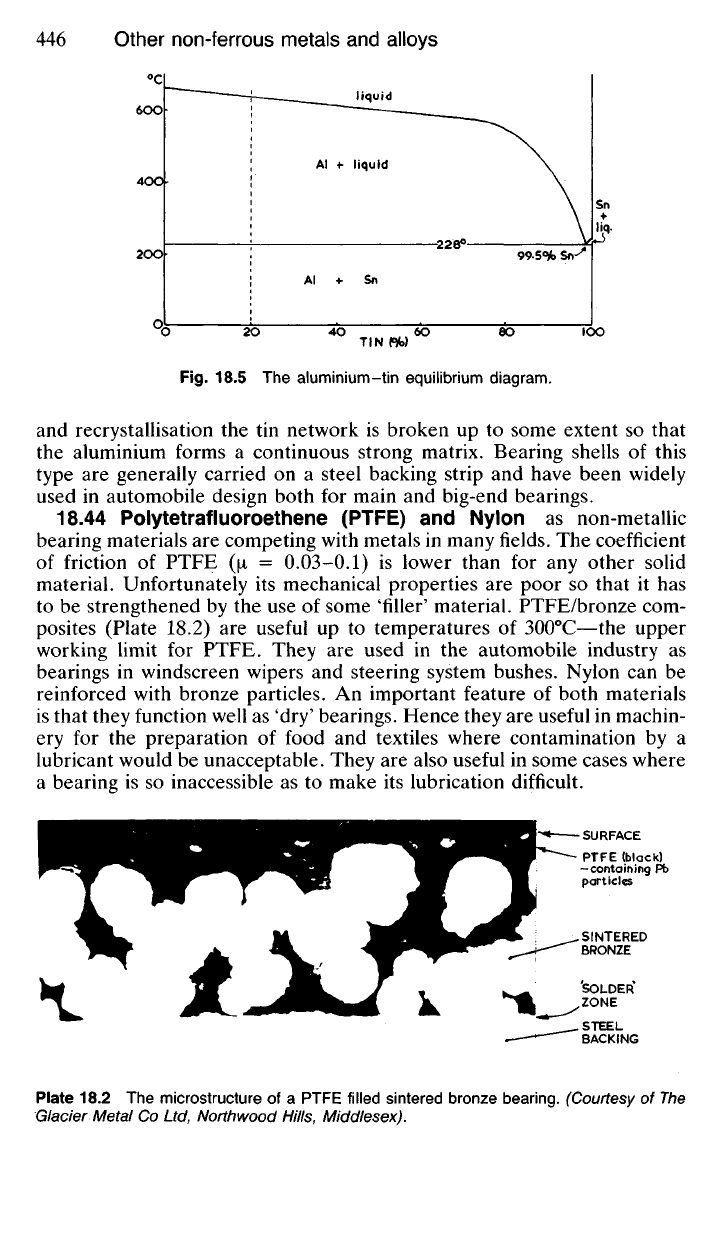
Fig.
18.5 The aluminium-tin equilibrium diagram.
and recrystallisation the tin network is broken up to some extent so that
the aluminium forms a continuous strong matrix. Bearing shells of this
type are generally carried on a steel backing strip and have been widely
used in automobile design both for main and big-end bearings.
18.44 Polytetrafluoroethene (PTFE) and Nylon as non-metallic
bearing materials are competing with metals in many fields. The coefficient
of friction of PTFE (\i = 0.03-0.1) is lower than for any other solid
material. Unfortunately its mechanical properties are poor so that it has
to be strengthened by the use of some 'filler' material. PTFE/bronze com-
posites (Plate 18.2) are useful up to temperatures of 300
0
C—the upper
working limit for PTFE. They are used in the automobile industry as
bearings in windscreen wipers and steering system bushes. Nylon can be
reinforced with bronze particles. An important feature of both materials
is that they function well as 'dry' bearings. Hence they are useful in machin-
ery for the preparation of food and textiles where contamination by a
lubricant would be unacceptable. They are also useful in some cases where
a bearing is so inaccessible as to make its lubrication difficult.
TIN
(Ph)
Al
+ liquid
liquid
0
C
Plate 18.2 The microstructure of a PTFE filled sintered bronze bearing. (Courtesy of The
Glacier Metal Co Ltd, Northwood Hills, Middlesex).
SURFACE
PTFE
(black)
-containing
Pb
particles
SINTERED
BRONZE
'SOLDER'
ZONE
STEEL
BACKING
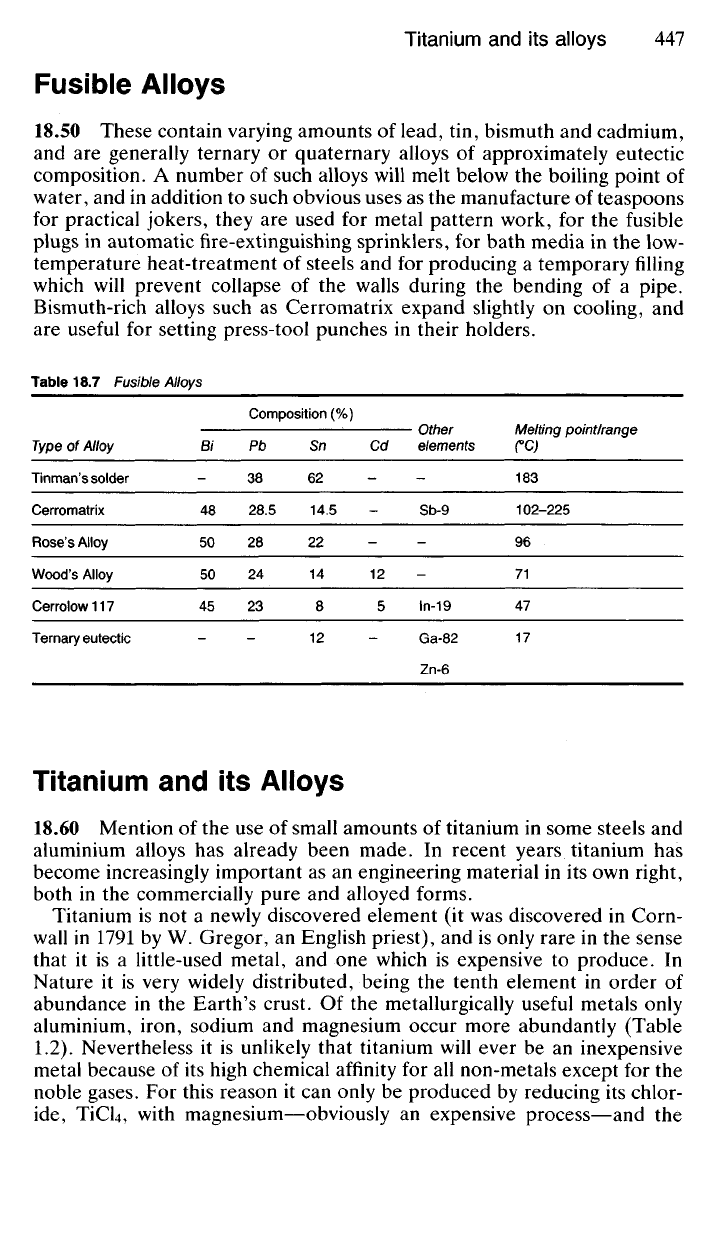
Fusible Alloys
18.50 These contain varying amounts of lead, tin, bismuth and cadmium,
and are generally ternary or quaternary alloys of approximately eutectic
composition. A number of such alloys will melt below the boiling point of
water, and in addition to such obvious uses as the manufacture of teaspoons
for practical jokers, they are used for metal pattern work, for the fusible
plugs in automatic fire-extinguishing sprinklers, for bath media in the low-
temperature heat-treatment of steels and for producing a temporary filling
which will prevent collapse of the walls during the bending of a pipe.
Bismuth-rich alloys such as Cerromatrix expand slightly on cooling, and
are useful for setting press-tool punches in their holders.
Table 18.7 Fusible Alloys
Composition (%)
Other Melting point/range
Type of Alloy Bi Pb Sn Cd elements CC)
Tinman's solder - 38 62 - - 183
Cerromatrix 48 28.5 14.5 - Sb-9 102-225
Rose's Alloy 50 28 22 96
Wood's Alloy 50 24 14 12 - 71
Cerrolow117 45 23 8 5 ln-19 47
Ternary eutectic - - 12 - Ga-82 17
Zn-6
Titanium and its Alloys
18.60 Mention of the use of small amounts of titanium in some steels and
aluminium alloys has already been made. In recent years titanium has
become increasingly important as an engineering material in its own right,
both in the commercially pure and alloyed forms.
Titanium is not a newly discovered element (it was discovered in Corn-
wall in 1791 by W. Gregor, an English priest), and is only rare in the sense
that it is a little-used metal, and one which is expensive to produce. In
Nature it is very widely distributed, being the tenth element in order of
abundance in the Earth's crust. Of the metallurgically useful metals only
aluminium, iron, sodium and magnesium occur more abundantly (Table
1.2). Nevertheless it is unlikely that titanium will ever be an inexpensive
metal because of its high chemical affinity for all non-metals except for the
noble gases. For this reason it can only be produced by reducing its chlor-
ide,
TiCU, with magnesium—obviously an expensive process—and the
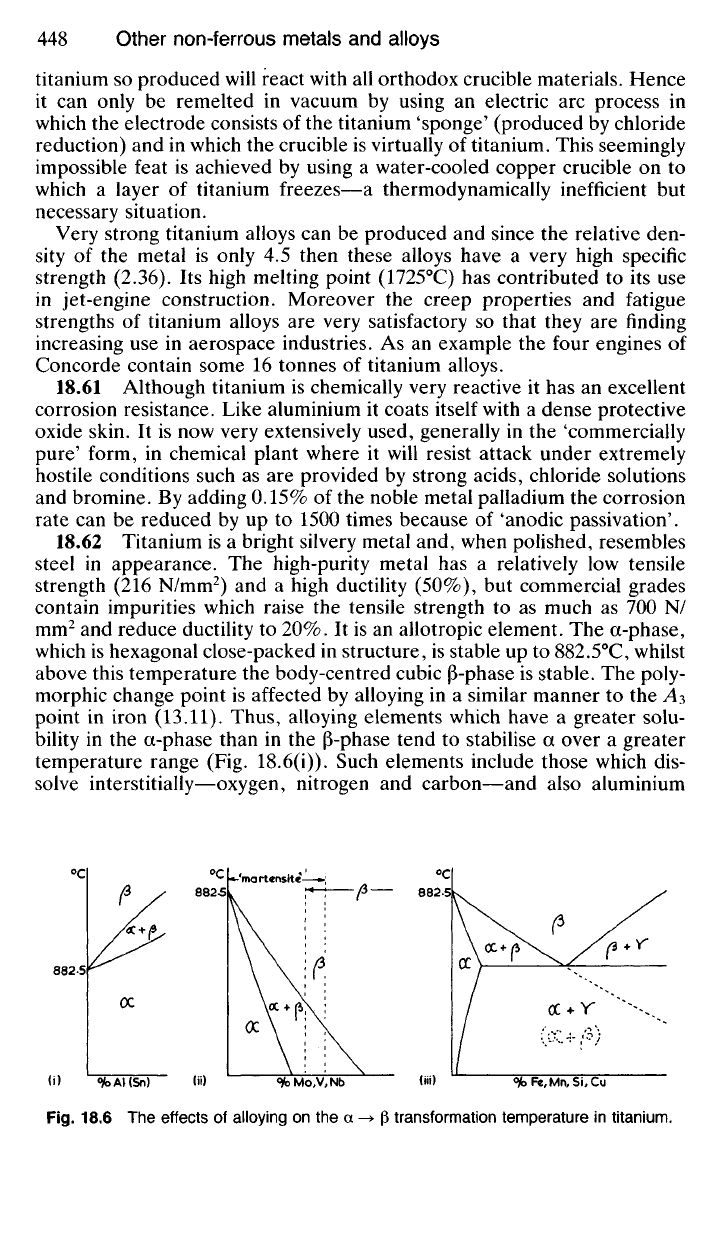
titanium so produced will react with all orthodox crucible materials. Hence
it can only be remelted in vacuum by using an electric arc process in
which the electrode consists of the titanium 'sponge' (produced by chloride
reduction) and in which the crucible is virtually of titanium. This seemingly
impossible feat is achieved by using a water-cooled copper crucible on to
which a layer of titanium freezes—a thermodynamically inefficient but
necessary situation.
Very strong titanium alloys can be produced and since the relative den-
sity of the metal is only 4.5 then these alloys have a very high specific
strength (2.36). Its high melting point (1725°C) has contributed to its use
in jet-engine construction. Moreover the creep properties and fatigue
strengths of titanium alloys are very satisfactory so that they are finding
increasing use in aerospace industries. As an example the four engines of
Concorde contain some 16 tonnes of titanium alloys.
18.61 Although titanium is chemically very reactive it has an excellent
corrosion resistance. Like aluminium it coats itself with a dense protective
oxide skin. It is now very extensively used, generally in the 'commercially
pure'
form, in chemical plant where it will resist attack under extremely
hostile conditions such as are provided by strong acids, chloride solutions
and bromine. By adding 0.15% of the noble metal palladium the corrosion
rate can be reduced by up to 1500 times because of 'anodic passivation'.
18.62 Titanium is a bright silvery metal and, when polished, resembles
steel in appearance. The high-purity metal has a relatively low tensile
strength (216 N/mm
2
) and a high ductility (50%), but commercial grades
contain impurities which raise the tensile strength to as much as 700 N/
mm
2
and reduce ductility to 20%. It is an allotropic element. The a-phase,
which is hexagonal close-packed in structure, is stable up to 882.5°C, whilst
above this temperature the body-centred cubic |3-phase is stable. The poly-
morphic change point is affected by alloying in a similar manner to the A3
point in iron (13.11). Thus, alloying elements which have a greater solu-
bility in the a-phase than in the (3-phase tend to stabilise a over a greater
temperature range (Fig. 18.6(i)). Such elements include those which dis-
solve interstitially—oxygen, nitrogen and carbon—and also aluminium
°c
°c
'martensite
0
C
°h AKSn) °h Mo,V, Nb <&Fe, Mn, Si, Cu
Fig.
18.6 The effects of alloying on the a -> (3 transformation temperature in titanium.
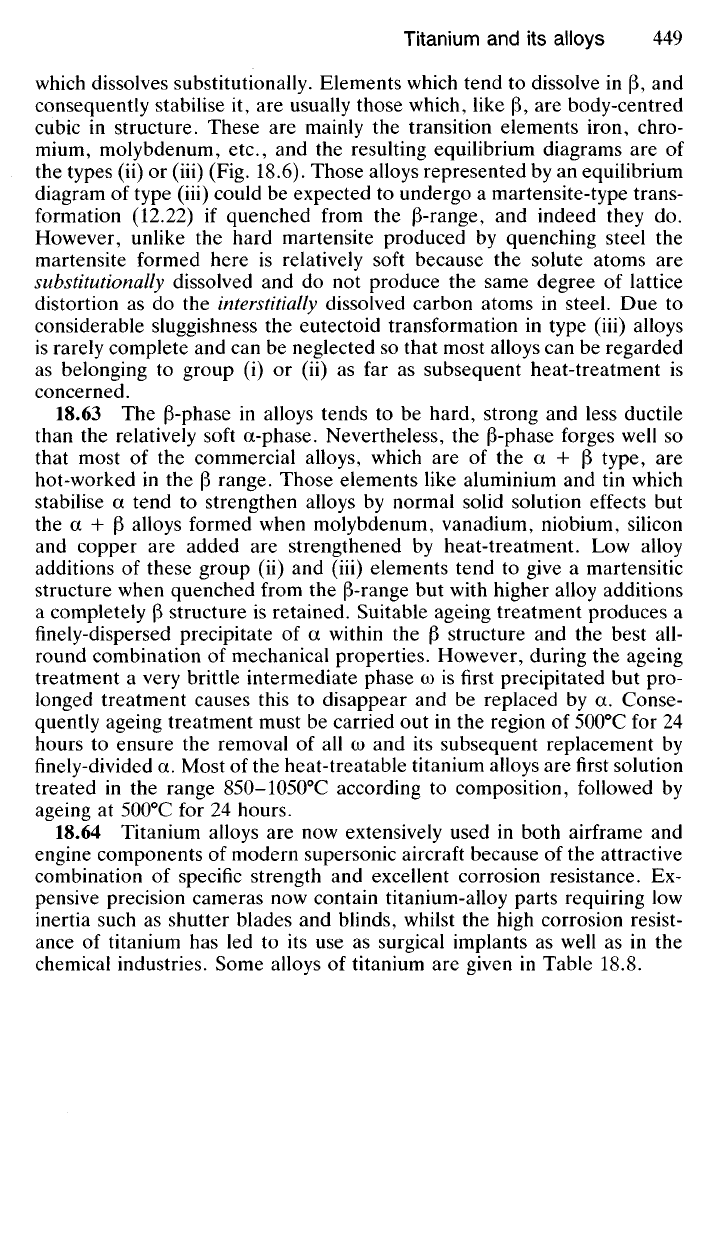
which dissolves substitutionally. Elements which tend to dissolve in |3, and
consequently stabilise it, are usually those which, like (3, are body-centred
cubic in structure. These are mainly the transition elements iron, chro-
mium, molybdenum, etc., and the resulting equilibrium diagrams are of
the types (ii) or (iii) (Fig. 18.6). Those alloys represented by an equilibrium
diagram of type (iii) could be expected to undergo a martensite-type trans-
formation (12.22) if quenched from the (3-range, and indeed they do.
However, unlike the hard martensite produced by quenching steel the
martensite formed here is relatively soft because the solute atoms are
substitutionally dissolved and do not produce the same degree of lattice
distortion as do the interstitially dissolved carbon atoms in steel. Due to
considerable sluggishness the eutectoid transformation in type (iii) alloys
is rarely complete and can be neglected so that most alloys can be regarded
as belonging to group (i) or (ii) as far as subsequent heat-treatment is
concerned.
18.63 The (3-phase in alloys tends to be hard, strong and less ductile
than the relatively soft a-phase. Nevertheless, the (3-phase forges well so
that most of the commercial alloys, which are of the a + |3 type, are
hot-worked in the (3 range. Those elements like aluminium and tin which
stabilise a tend to strengthen alloys by normal solid solution effects but
the a + (3 alloys formed when molybdenum, vanadium, niobium, silicon
and copper are added are strengthened by heat-treatment. Low alloy
additions of these group (ii) and (iii) elements tend to give a martensitic
structure when quenched from the (3-range but with higher alloy additions
a completely (3 structure is retained. Suitable ageing treatment produces a
finely-dispersed precipitate of a within the (3 structure and the best all-
round combination of mechanical properties. However, during the ageing
treatment a very brittle intermediate phase oo is first precipitated but pro-
longed treatment causes this to disappear and be replaced by a. Conse-
quently ageing treatment must be carried out in the region of 500
0
C for 24
hours to ensure the removal of all oo and its subsequent replacement by
finely-divided a. Most of the heat-treatable titanium alloys are first solution
treated in the range 850-1050
0
C according to composition, followed by
ageing at 500
0
C for 24 hours.
18.64 Titanium alloys are now extensively used in both airframe and
engine components of modern supersonic aircraft because of the attractive
combination of specific strength and excellent corrosion resistance. Ex-
pensive precision cameras now contain titanium-alloy parts requiring low
inertia such as shutter blades and blinds, whilst the high corrosion resist-
ance of titanium has led to its use as surgical implants as well as in the
chemical industries. Some alloys of titanium are given in Table 18.8.
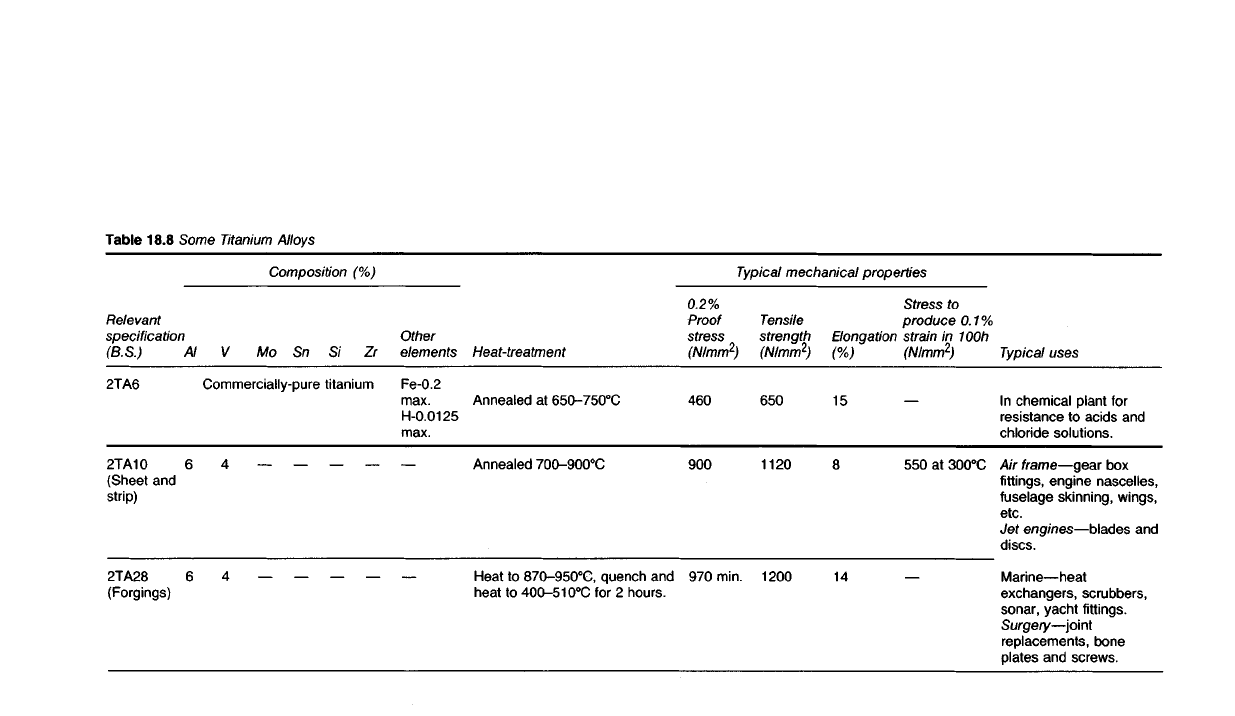
Table
18.8
Some Titanium Alloys
Typical
mechanical
properties
Composition
(%)
Typical
uses
In
chemical plant for
resistance
to
acids
and
chloride solutions.
Air
frame—gear box
fittings,
engine nascelles,
fuselage skinning, wings,
etc.
Jet
engines—blades
and
discs.
Marine—heat
exchangers, scrubbers,
sonar, yacht fittings.
Surgery—joint
replacements, bone
plates
and
screws.
Stress
to
produce
0.1%
strain
in
10Oh
(N/mm
2
)
550
at
300
0
C
Elongation
(%)
15
8
14
Tensile
strength
(N/mm
2
)
650
1120
1200
0.2%
Proof
stress
(N/mm
2
)
460
900
970 min.
Heat-treatment
Annealed
at 650-750
0
C
Annealed
700-900
0
C
Heat
to 870-950
0
C,
quench
and
heat
to 400-510
0
C
for
2
hours.
Other
elements
Fe-0.2
max.
H-0.0125
max.
Zr
Si
Sn
Mo
V
Al
Commercially-pure
titanium
4
4
6
6
Relevant
specification
(B.S.)
2TA6
2TA10
(Sheet
and
strip)
2TA28
(Forgings)
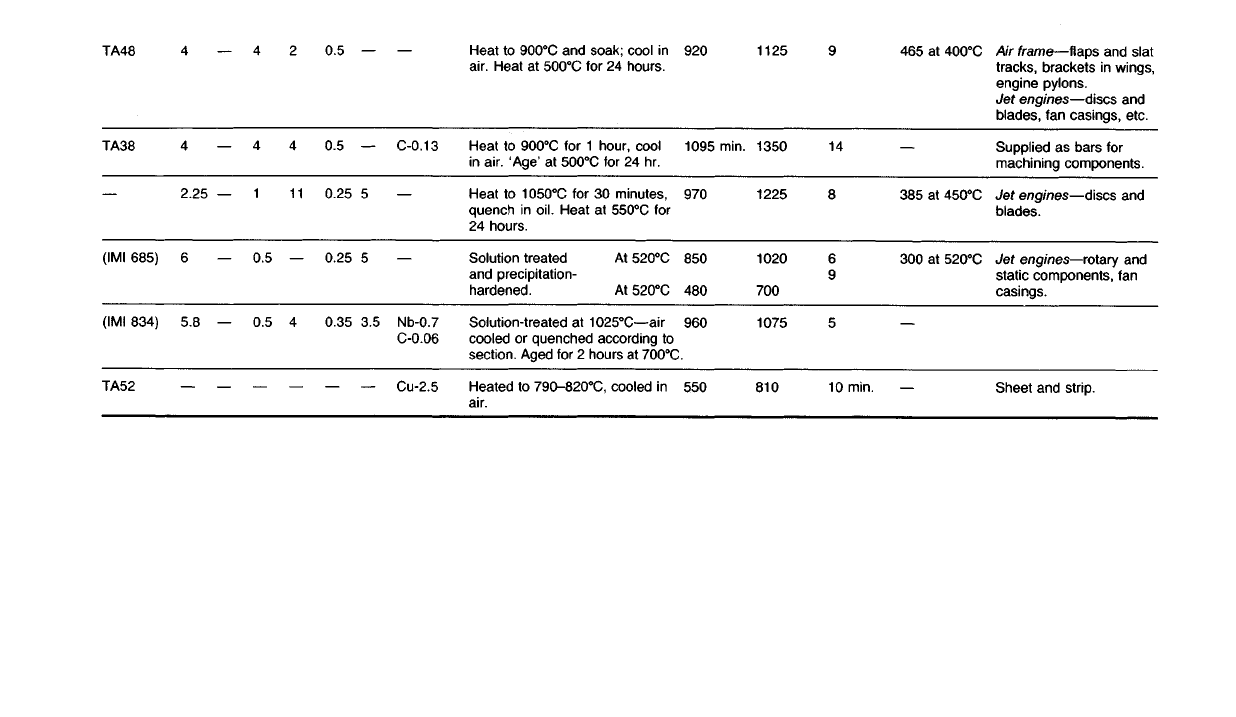
Air
frame—flaps and slat
tracks,
brackets in wings,
engine pylons.
Jet
engines—discs and
blades, fan casings, etc.
Supplied as bars for
machining components.
Jet
engines—discs and
blades.
Jet
engines—rotary and
static
components, fan
casings.
Sheet and strip.
465 at
400
0
C
385 at
450
0
C
300 at
520
0
C
9
14
8
6
9
5
10 min.
1125
1350
1225
1020
700
1075
810
920
1095 min.
970
850
480
960
550
Heat to
900
0
C
and soak; cool in
air.
Heat at
500
0
C
for 24 hours.
Heat to
900
0
C
for 1 hour, cool
in
air. 'Age' at
500
0
C
for 24 hr.
Heat
to
1050°C
for 30 minutes,
quench in oil. Heat at
550
0
C
for
24 hours.
At
520
0
C
At
520°C
Solution
treated
and precipitation-
hardened.
Solution-treated at 1025°C—air
cooled or quenched according to
section.
Aged for 2 hours at
700
0
C.
Heated to
790-820
0
C,
cooled in
air.
C-0.13
Nb-0.7
C-0.06
Cu-2.5
5
5
3.5
0.5
0.5
0.25
0.25
0.35
2
4
11
4
4
4
0.5
0.5
4
4
2.25
6
5.8
TA48
TA38
(IMI 685)
(IMI 834)
TA52
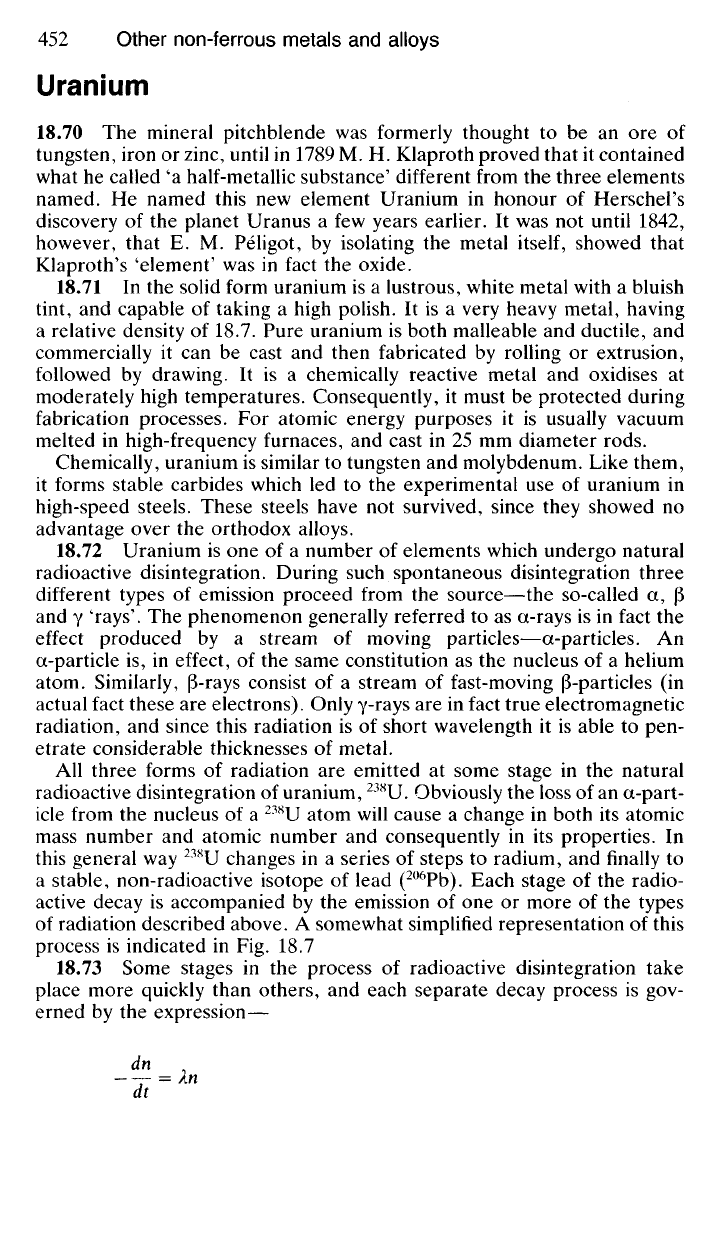
Uranium
18.70 The mineral pitchblende was formerly thought to be an ore of
tungsten, iron or zinc, until in 1789 M. H. Klaproth proved that it contained
what he called 'a half-metallic substance' different from the three elements
named. He named this new element Uranium in honour of Herschel's
discovery of the planet Uranus a few years earlier. It was not until 1842,
however, that E. M. Peligot, by isolating the metal
itself,
showed that
Klaproth's 'element' was in fact the oxide.
18.71 In the solid form uranium is a lustrous, white metal with a bluish
tint, and capable of taking a high polish. It is a very heavy metal, having
a relative density of 18.7. Pure uranium is both malleable and ductile, and
commercially it can be cast and then fabricated by rolling or extrusion,
followed by drawing. It is a chemically reactive metal and oxidises at
moderately high temperatures. Consequently, it must be protected during
fabrication processes. For atomic energy purposes it is usually vacuum
melted in high-frequency furnaces, and cast in 25 mm diameter rods.
Chemically, uranium is similar to tungsten and molybdenum. Like them,
it forms stable carbides which led to the experimental use of uranium in
high-speed steels. These steels have not survived, since they showed no
advantage over the orthodox alloys.
18.72 Uranium is one of a number of elements which undergo natural
radioactive disintegration. During such spontaneous disintegration three
different types of emission proceed from the source—the so-called a, (3
and
Y
'rays'. The phenomenon generally referred to as a-rays is in fact the
effect produced by a stream of moving particles—a-particles. An
a-particle is, in effect, of the same constitution as the nucleus of a helium
atom. Similarly, (3-rays consist of a stream of fast-moving |3-particles (in
actual fact these are electrons). Only y-rays are in fact true electromagnetic
radiation, and since this radiation is of short wavelength it is able to pen-
etrate considerable thicknesses of metal.
All three forms of radiation are emitted at some stage in the natural
radioactive disintegration of uranium,
238
U. Obviously the loss of an a-part-
icle from the nucleus of a
238
U atom will cause a change in both its atomic
mass number and atomic number and consequently in its properties. In
this general way
238
U changes in a series of steps to radium, and finally to
a stable, non-radioactive isotope of lead (
206
Pb). Each stage of the radio-
active decay is accompanied by the emission of one or more of the types
of radiation described above. A somewhat simplified representation of this
process is indicated in Fig. 18.7
18.73 Some stages in the process of radioactive disintegration take
place more quickly than others, and each separate decay process is gov-
erned by the expression—
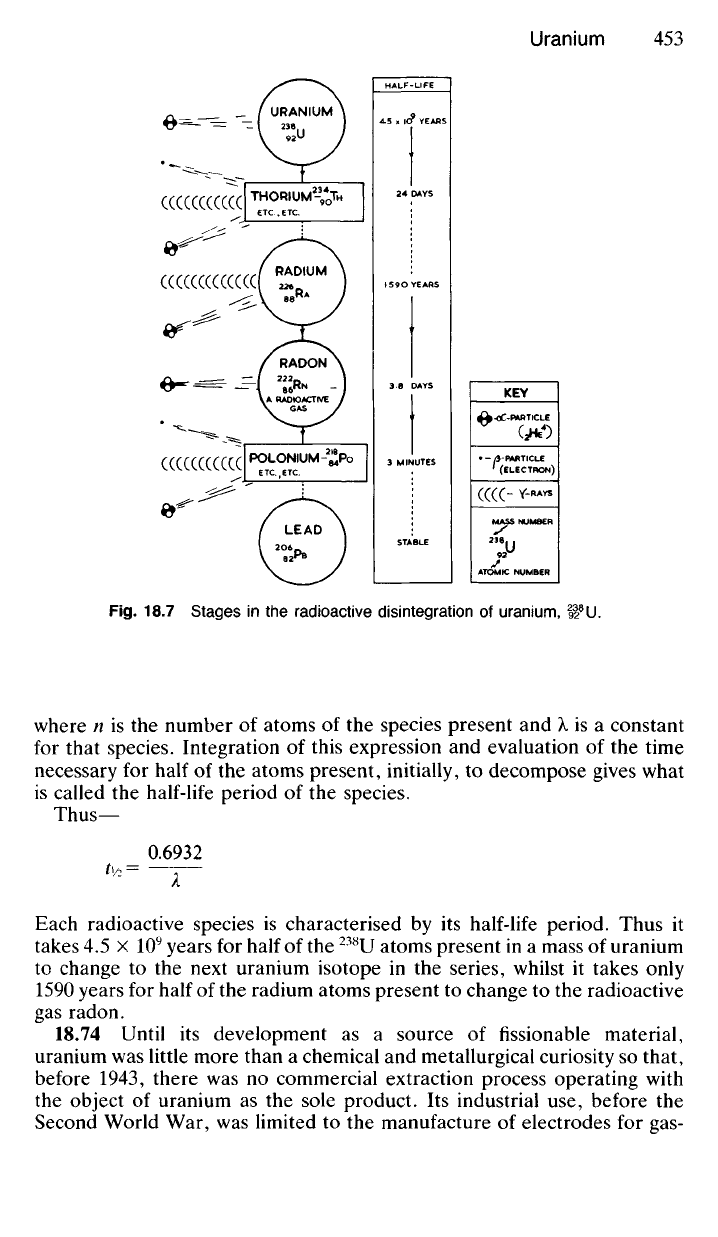
Fig.
18.7 Stages in the radioactive disintegration of uranium, H
8
U.
where n is the number of atoms of the species present and X is a constant
for that species. Integration of this expression and evaluation of the time
necessary for half of the atoms present, initially, to decompose gives what
is called the half-life period of the species.
Thus—
0.6932
^=-r~
Each radioactive species is characterised by its half-life period. Thus it
takes 4.5 x 10
9
years for half of the
238
U atoms present in a mass of uranium
to change to the next uranium isotope in the series, whilst it takes only
1590 years for half of the radium atoms present to change to the radioactive
gas radon.
18.74 Until its development as a source of fissionable material,
uranium was little more than a chemical and metallurgical curiosity so that,
before 1943, there was no commercial extraction process operating with
the object of uranium as the sole product. Its industrial use, before the
Second World War, was limited to the manufacture of electrodes for gas-
URANlUM
2
Su
HALF-LIFE
THORI
UM
2
-
9
QTH
ETC.
E
TC.
RADIUM
236-
88
R
*
4.5 x IC? YEARS
24 DAYS
RADON
A
RADIOACTIVE
GAS
POLONIUM-™Po
ETC
1
ETC.
LEAD
206
PB
82
KB
3.8 DAYS
3 MINUTES
STABLE
I59O YEARS
KEY
Of-RARTlCLE
/3-PARTICLE
'(ELECTRON)
Y-RAYS
MASS NUMBER
238
U
92
ATOMIC NUMBER
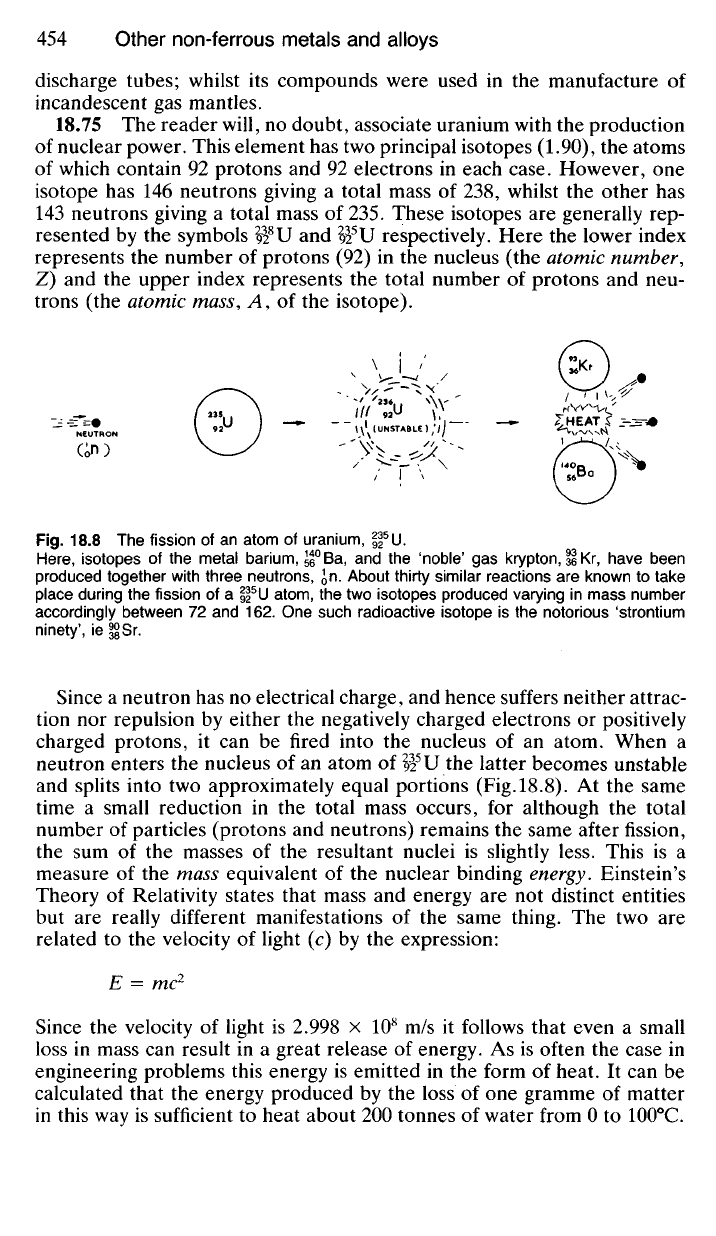
discharge tubes; whilst
its
compounds were used
in the
manufacture
of
incandescent
gas
mantles.
18.75
The
reader will,
no
doubt, associate uranium with
the
production
of nuclear power. This element
has two
principal isotopes (1.90),
the
atoms
of which contain
92
protons
and 92
electrons
in
each case. However,
one
isotope
has 146
neutrons giving
a
total mass
of
238,
whilst
the
other
has
143 neutrons giving
a
total mass
of
235. These isotopes
are
generally
rep-
resented
by the
symbols 92
3
U
and
92
5
U respectively. Here
the
lower index
represents
the
number
of
protons
(92)
in
the
nucleus
(the
atomic number,
Z)
and the
upper index represents
the
total number
of
protons
and neu-
trons
(the
atomic mass,
A, of
the
isotope).
Fig.
18.8 The
fission
of
an
atom
of
uranium,
|f
U.
Here,
isotopes
of
the
metal barium, 55
0
Ba,
and the
'noble'
gas
krypton,
Il
Kr,
have been
produced together with three neutrons,
Jn.
About thirty similar reactions
are
known
to
take
place during
the
fission
of a
H
5
U
atom,
the two
isotopes produced varying
in
mass number
accordingly between
72 and 162. One
such radioactive isotope
is
the
notorious 'strontium
ninety',
ie
§jjSr.
Since
a
neutron
has no
electrical charge,
and
hence suffers neither attrac-
tion
nor
repulsion
by
either
the
negatively charged electrons
or
positively
charged protons,
it
can
be
fired into
the
nucleus
of an
atom. When
a
neutron enters
the
nucleus
of
an
atom
of
92
5
U
the
latter becomes unstable
and splits into
two
approximately equal portions (Fig.18.8).
At
the
same
time
a
small reduction
in the
total mass occurs,
for
although
the
total
number
of
particles (protons
and
neutrons) remains
the
same after fission,
the
sum
of
the
masses
of
the
resultant nuclei
is
slightly less. This
is a
measure
of
the
mass equivalent
of
the
nuclear binding energy. Einstein's
Theory
of
Relativity states that mass
and
energy
are not
distinct entities
but
are
really different manifestations
of
the
same thing.
The two
are
related
to
the
velocity
of
light
(c) by the
expression:
E
= me
2
Since
the
velocity
of
light
is
2.998
x
10
8
m/s
it
follows that even
a
small
loss
in
mass
can
result
in a
great release
of
energy.
As
is
often
the
case
in
engineering problems this energy
is
emitted
in
the
form
of
heat.
It
can
be
calculated that
the
energy produced
by the
loss
of
one
gramme
of
matter
in this
way
is
sufficient
to
heat about
200
tonnes
of
water from
0
to
100
0
C.
NEUTRON
"
5
U
(UNSTABLE)
a
2u
9
V
HEAT
I4O
Q
56
Ba
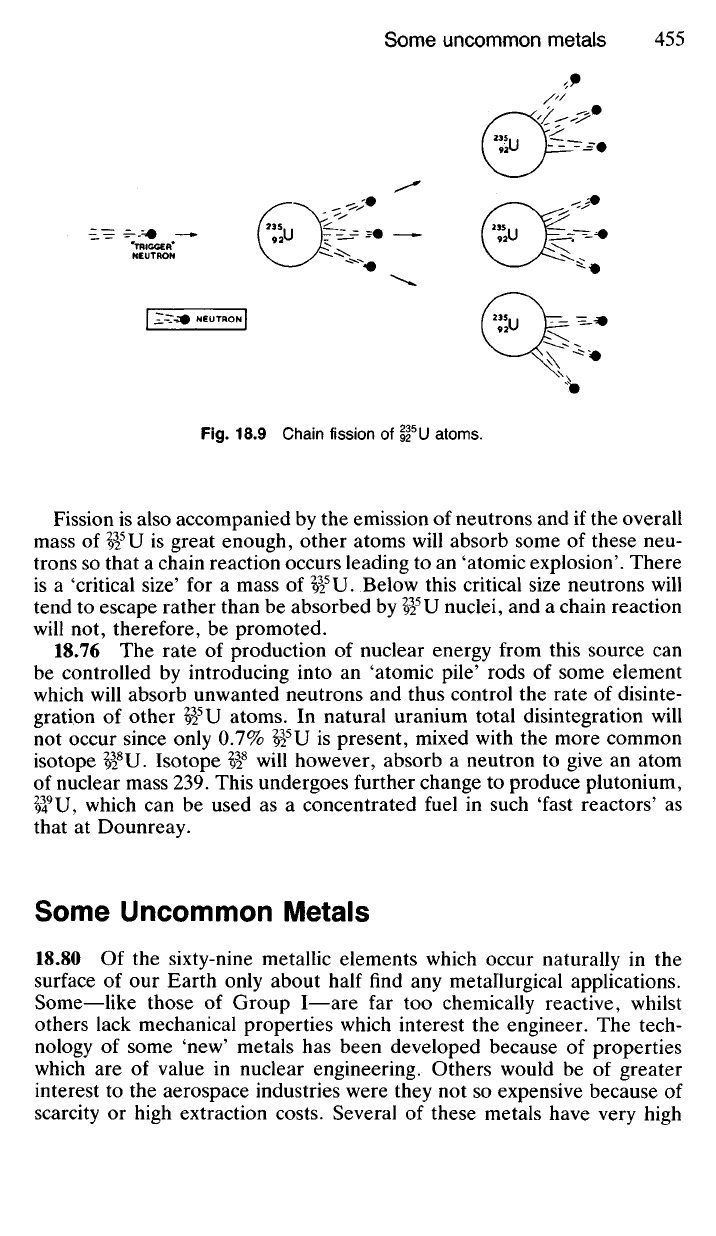
Fig.
18.9
Chain fission
of
92
5
U atoms.
Fission
is
also accompanied
by the
emission
of
neutrons
and if
the overall
mass
of
92
5
U
is
great enough, other atoms will absorb some
of
these
neu-
trons
so
that
a
chain reaction occurs leading
to an
'atomic explosion'. There
is
a
'critical size'
for a
mass
of
92
5
U. Below this critical size neutrons will
tend
to
escape rather than
be
absorbed
by
92
5
U nuclei,
and a
chain reaction
will
not,
therefore,
be
promoted.
18.76
The
rate
of
production
of
nuclear energy from this source
can
be controlled
by
introducing into
an
'atomic pile' rods
of
some element
which will absorb unwanted neutrons
and
thus control
the
rate
of
disinte-
gration
of
other 92
5
U atoms.
In
natural uranium total disintegration will
not occur since only 0.7% 92
5
U
is
present, mixed with
the
more common
isotope 92
8
U. Isotope
92
s
will however, absorb
a
neutron
to
give
an
atom
of nuclear mass 239. This undergoes further change
to
produce plutonium,
94
9
U, which
can be
used
as a
concentrated fuel
in
such 'fast reactors'
as
that
at
Dounreay.
Some Uncommon Metals
18.80
Of the
sixty-nine metallic elements which occur naturally
in the
surface
of our
Earth only about half find
any
metallurgical applications.
Some—like those
of
Group I—are
far too
chemically reactive, whilst
others lack mechanical properties which interest
the
engineer.
The
tech-
nology
of
some
'new'
metals
has
been developed because
of
properties
which
are of
value
in
nuclear engineering. Others would
be of
greater
interest
to the
aerospace industries were they
not so
expensive because
of
scarcity
or
high extraction costs. Several
of
these metals have very high
"TRIGGER*
NEUTRON
NEUTRON
'Uu
1
Su
'Su
T,u
